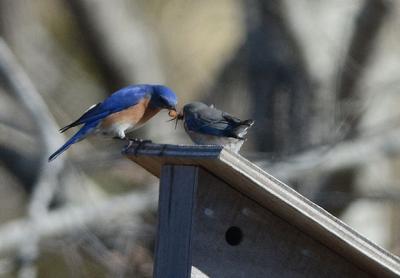Nature Notes: Bluebirds on the Rise

In last week’s column, I wrote about the beginning of the local eastern bluebird season. Then I received Joe Giunta’s annual recap of the East Hampton Town area’s bluebird box yield for 2017. Joe and his volunteers have been checking out and maintaining the boxes at nine different East Hampton Town sites and two boxes on North Haven in Southampton Town for nearly 20 years.
These boxes, originally made by the late Kim Hicks of Montauk, were first installed by the South Fork Natural History Society and East Hampton’s Natural Resources Department in 1987. At that time, there were only a few pairs of the official New York State bird breeding on the South Fork. They had been decimated in the middle 1960s in the same way that the osprey population was decimated, by DDT and other pesticides.
East Hampton Airport was one of the first sites chosen because of its openness, consisting mostly of grassy fields. Commuter plane and helicopter traffic in the 1980s was much, much less than it is today. While the airport was being modernized and expanded in the 1990s, a Department of Agriculture agent came around and asked me to remove the boxes because birds at landing fields could cause accidents. Somehow, I never got around to removing them. In fact, more were put up.
Bluebirds and tree sparrows began showing up, so we knew that we were on to something. The first few years were low in productivity. Kari Lyn Jones did most of the monitoring. But things picked up as more boxes were added. Then the bluebird population began to burgeon. Breeding bluebirds were soon joined by tree swallows and house wrens. In 2016, a great-crested flycatcher pair used one of the boxes for the first time. Instead of hanging a molted snake skin, which is one of their peculiarities, the flycatchers hung a piece of plastic ribbon from the box. During the same period the New York State Bluebird Society formed and soon the state bird was reoccupying its perch across the state.
If it weren’t for Kari Lyn, then Joe and the helpers, however, where would we be? Probably not much better than the meager population found here in the early 1980s. Running a bluebird trail entails a lot of work. The boxes have to be cleaned annually and new boxes are put up regularly to replace dysfunctional ones. At the largest population site, East Hampton Airport, the boxes were put up close to the woods. That worked for a while, but when the South Fork flying squirrel population began to increase in the first decade of the millennium, many boxes and their broods began to be predated.
Joe began removing those near the tree line and reinstalling them about 15 feet out from it, which greatly reduced the amount of squirrel predation. He also equipped the posts with raccoon guards.
When one examines the annual records, it is easy to see how much the bluebirds and tree swallows benefited from such work. For example, during the height of flying squirrel predation in the summer of 2015, not a single bluebird fledged, compared to the record year, 2012, when 143 fledged throughout the system. Then in 2016 the number of successful bluebird fledglings at the airport shot up to 100. In 2017, the number climbed to 111, the second largest ever.
Of course, other factors came into play as well. Climate, in terms of storms and rainfall, plays a part. Food stocks, in the form of insects, are also very important in determining a good year versus a bad one. It is even conceivable that reducing the flight traffic at the airport played a role. For the first time in years, during my annual South Fork summer whippoorwill census I found at least three pairs of whippoorwills breeding in the woods around the airport, as opposed to none in several years prior to the town’s imposing limits.
The airport had by far the most successful breeding bluebirds and tree swallows compared to the other 10 sites surveyed. There were 82 bluebird fledges and 104 tree swallow fledges. The next most successful fledging area surveyed was the edges of the Barcelona golf course, with 21 bluebirds and 27 tree swallows. Tree swallows are adept at catching insects — including mosquitoes, gnats, and green-eyed flies — on the wing. It is hoped that the golfers got some relief from these biting insects by virtue of the bluebirds and tree swallows there.
Mr. Giunta’s census taking for the 13 consecutive years beginning in 2005 altogether accounted for 896 bluebird and 287 tree swallow fledges, 79 of which were counted at the South Fork Country Club in Amagansett, the second most productive area locally. Last year, along with the fledglings from these two species, 74 new house wrens came out of the box holes for a grand total of 1,257 fledges in all.
During the nonbreeding season, Joe, who is an excellent birder, leads tours in more southern climes. In fact, he just got back from leading a tour in Costa Rica. Now we have him for the spring and summer breeding season. Where would we be without Joe and his helpers? And let’s see if the increased traffic at the airport yields as high numbers of fledges this year as last.
On the East End of Long Island, both the official state and national birds are back as regular breeders. Who says we aren’t making progress?
Larry Penny can be reached via email at [email protected].
